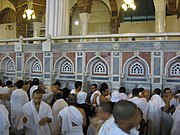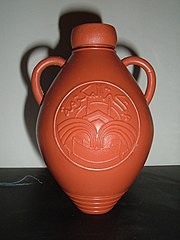- Zamzam redirects here. For the Iranian soft drink company Zam Zam Group (named after this well), see Zam Zam Cola.

Pilgrims visiting the Well
The Well of Zamzam (or the Zamzam Well, or just Zamzam; Arabic: زمزم) is a Well located within the Masjid al Haram in Mecca, 20 meters east of the Kaaba,[1] the holiest place in Islam. According to Islamic belief, it was a miraculously-generated source of water from God, which began thousands of years ago when Ibrahim's infant son Ismael was thirsty and kept crying for water and was kicking at the ground when water gushed out. Millions of pilgrims visit the Well each year while performing the Hajj or Umrah pilgrimages, in order to drink its water. By Saudi law, the water cannot be sold outside of the kingdom, but because of strong demand, there is a thriving market in fake Zamzam water in other countries.
Origin of Zamzam[]
Islamic history states that Zamzam well was revealed to Hajar, the wife of Abraham (Ibrahim) and mother of Ismail,[2] around the year 2000 BC. According to Islamic tradition, she was desperately seeking water for her infant son, but could find none, as Makkah is located in a hot dry valley with few sources of water. Muslim traditions say that Hajar ran seven times back and forth in the scorching heat between the two hills of Safa and Marwah, looking for water. Getting thirstier by the second, her son, Ismael anxiously scraped the land with his feet, where suddenly water sprang out. There are other versions of the story involving Allah sending his angel, Gabriel, who touched the ground where water rose.[3]
The name of the well comes from the phrase Zomë Zomë, meaning ‘accumulate’, a command repeated by Hajar during her attempt to contain the spring water.[1]
According to Islamic tradition, Abraham rebuilt the Bait-ul-Allah (House of God) near the site of the well, a building which had been originally constructed by Adam, and today is called the Kaaba, a building towards which all Muslims around the world face in prayer, five times each day. The Zamzam well is located approximately 20 meters east of the Kaaba.[1]
History[]
According to Islam Online, the well originally had two cisterns in the first era, one for drinking and one for ablution.[4] At that time, it was a simple well surrounded by a fence of stones. Then in the era of the Abbasid caliph Abu Ja`far Al-Mansur 771 AD (149 AH) a dome was built above the well, and it was tiled with marble. In 775 AD (153 AH), Al-Mahdi rebuilt the well during his caliphate, and built a dome of teak which was covered with mosaic. One small dome covered the Well, and a larger dome covered the room for the pilgrims. In 835 AD (213 AH) there was further restoration, and the dome was covered with marble during the caliphate of Al-Mu`tasim.[3]
In 1417 (795 AH), during the time of the Mamluks, the Mosque was damaged by fire, and required restoration. Further restoration occurred in 1430 (808 AH), and again in 1499 (877 AH) during the time of Sultan Qaitbai, when the marble was replaced.[3]
In modern times, the most extensive restoration took place to the dome during the era of the Ottoman Sultan Abdul Hamid II in 1915 (1333 AH). To facilitate crowd control, the building housing the Zamzam was moved away from its original location, to get it out of the way of the Tawaf, when millions of pilgrims would circumambulate the Kaaba. The water of the well is now pumped to the eastern part of the Mosque, where it was made available in separate locations for men and women.[3]
Technical information[]
The Zamzam well was excavated by hand, and is about 30 metres deep and 1.08 to 2.66 metres in diameter. It taps groundwater from the wadi alluvium and some from the bedrock. Originally water from the well was drawn via ropes and buckets, but today the well itself is in a basement room where it can be seen behind glass panels (visitors are not allowed to enter). Electric pumps draw the water, which is available throughout the Masjid via water fountains and dispensing containers near the Tawaf area.[1]
Hydrogeologically, the well is in the Wadi Ibrahim (Valley of Abraham). The upper half of the well is in the sandy alluvium of the valley, lined with stone masonry except for the top metre which has a concrete "collar". The lower half is in the bedrock. Between the alluvium and the bedrock is a half-metre section of permeable weathered rock, lined with stone, and it is this section that provides the main water entry into the well. Water in the well comes from absorbed rainfall in the Wadi Ibrahim, as well as run-off from the local hills. Since the area has become more and more settled, water from absorbed rainfall on the Wadi Ibrahim has decreased.
The Saudi Geological Survey has a "Zamzam Studies and Research Centre" which analyses the technical properties of the well in detail. Water levels were monitored by hydrograph, which in more recent times has changed to a digital monitoring system that tracks the water level, electric conductivity, pH, Eh, and temperature. All of this information is made continuously available via the Internet. Other wells throughout the valley have also been established, some with digital recorders, to monitor the response of the local aquifer system.[1]
The water level is 3.23 metres (about 10.59 ft) below the surface. A pumping test at 8000 litres/second for more than a 24 hour period showed a drop in water level from 3.23 metres below surface to 12.72 metres and then to 13.39 metres, after which the water level stopped receding. When pumping stopped, the water level recovered to 3.9 metres below surface only 11 minutes later. This data shows that the aquifer feeding the well seems to recharge from rock fractures in neighbouring mountains around Mecca.
Zamzam Water has no colour or smell, but it has a distinct taste, and its pH is 7.9–8.0, indicating that it is alkaline to some extent.
Sodium chloride (common salt) is in excess in Zamzam making it taste salty. By the result of the hardness in the water, Muslims believe that Zamzam is beneficial for health. They also claim that the excess amount of sodium does not cause any harmful effects. An independent study of the water has not been done so far.
Minerals Percentages
Calcium 198
Magnesium 43.7
Chloride 335
Sulfur 370
Iron 0.15
Manganese 0.15
Copper 0.12
(Analysis of a study conducted in the laboratory of the Department of Water and Waste Water Treatment, the Western Province, Saudi Arabia, 1400 H.E.)
Commercial sale of Zamzam[]

In Europe, Zamzam is frequently encountered in bottles such as these
The Saudi government has prohibited the commercial export of Zamzam from the kingdom. However, there is a strong commercial demand for Zamzam which resulted in commercial distribution of fake Zamzam along with alleged Zamzam in many countries.
Notes[]
- ↑ 1.0 1.1 1.2 1.3 1.4 "Zamzam Studies and Research Centre". Saudi Geological Survey. http://www.sgs.org.sa/index.cfm?sec=311&page=. Retrieved 2005-06-05.
- ↑ Bob Trubshaw (February 1993). "The Black Stone - the Omphalos of the Goddess" ([dead link] – Scholar search). Mercian Mysteries (No. 14). http://www.indigogroup.co.uk/edge/blstone.htm.
- ↑ 3.0 3.1 3.2 3.3 Shil, Mahmoud Isma`il & `Abdul-Wahid, `Abdur-Rahman. "The Well of Zam zam". IslamOnline. http://www.islamonline.net/English/hajj/Landmarks/1425/08.shtml. Retrieved 2005-06-06.
- ↑ Mahmoud Isma'il Shil and 'Abdur-Rahman 'Abdul-Wahid. "Historic Places: The Well of Zamzam". http://www.islamonline.net/English/hajj/2002/01/stories/article4.shtml. Retrieved 2008-08-06.
References[]
- Hawting, G. R. (1980). "The Disappearance and Rediscovery of Zamzam and the 'Well of the Ka'ba'". Bulletin of the School of Oriental and African Studies, University of London 43 (1): 44–54. http://links.jstor.org/sici?sici=0041-977X(1980)43%3A1%3C44%3ATDAROZ%3E2.0.CO%3B2-3.
External links[]
| Wikimedia Commons has media related to: Zamzam Well |
- Careem, S. H. A. "The Miracle of Zamzam". Sunday Observer. http://www.sundayobserver.lk/2005/01/30/fea36.html. Retrieved 2005-06-05. Provides a brief history of the well and some information on the health benefits of Zamzam water.
- Saudi Geological Survey's Zamzam Studies and Research Center. On activities carried out by the center to secure the supply, in terms of quality and quantity, of Zamzam water.
Coordinates: 21°25′19″N 39°49′34″E / 21.422°N 39.826°E
ar:بئر زمزم bs:Zem-Zem ca:Pou de Zamzam cs:Zamzam da:Zamzam-kilden eu:Zamzam putzua fa:چاه زمزم id:Zamzam hu:Zamzam kút ml:സംസം mr:झमझम विहीर ms:Telaga Zam-Zam ja:ザムザムの泉 ru:Замзам sv:Zamzam th:ซัมซัม tk:Aby-Zemzem zh:滲滲泉